Everyone deserves to see themselves in a Magic card.
Especially in recent years, Wizards has committed itself to consciously portraying a Multiverse that is as diverse as our own world, if not moreso. To celebrate that, I’ve selected 10 cards that showcase Magic’s best attempts to represent the diversity of our community, with a special focus towards highlighting cards that are underappreciated or have historically flown under the radar.
Keep in mind this isn’t a strictly ranked list. Instead, I ordered my picks to tell a compelling story as we journey through Magic’s past, present, and possibly even future.
Let’s begin!
10. Serra Angel
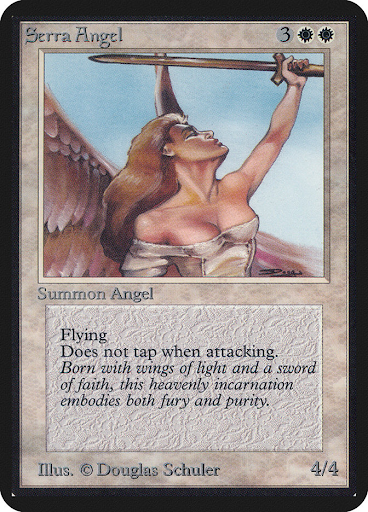
Taken collectively, the art of Magic’s very first set, Alpha, was as beautiful and singular as it was baffling and incoherent. Given that Alpha contained one card which was outright banned for being culturally offensive, as well as multiple incredibly racy and objectifying illustrations, Magic’s art did not hit all the high notes right out of the gate.
And yet.
From the beginning, there was also Serra Angel.
Her iconic sword, held triumphantly aloft, draws the eye immediately, thanks to both the negative space of the simple background and Serra Angel herself beholding her weapon in-frame. While aspects of her illustration certainly flirt with being yet another example of the male gaze, the card as a whole tells a different story. Her statline, flavor text, and art all combine to say the same thing: I am powerful.
For many, Serra Angel proves that powerful women have always had a place in Magic.
9. Rocco, Cabaretti Caterer
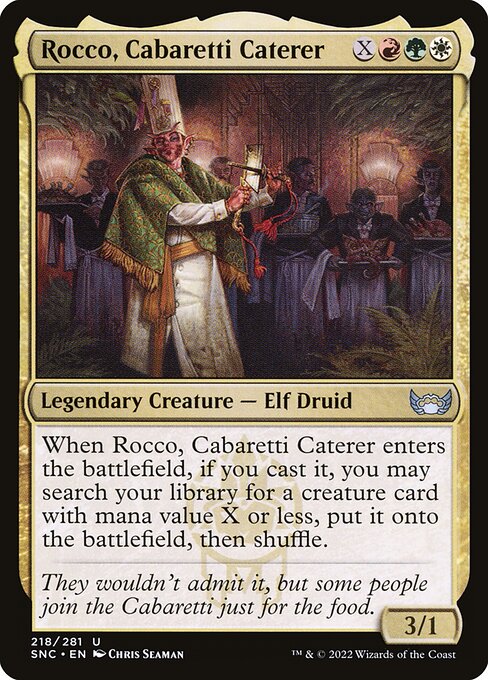
Did you know Rocco, the Cabaretti’s plane-renowned caterer, is non-binary? You could be forgiven for not realizing that, especially if you aren’t in the habit of reading Magic’s on-again, off-again web story installments. But Rocco’s pronouns are also clearly demonstrated through the flavor text of Warm Welcome.
Unlike many others on this list, Rocco is not a “first” or an “only.” But Rocco holds a special place in my heart because their gender was demonstrated via the cards themselves. It’s very exciting to have a non-binary character whose identity is an indelible part of the cards of Streets of New Capenna.
In recent years, Magic has loudly put its narrative weight behind trans and non-binary heroes like Niko Aris, Alesha, Who Smiles at Death, and Yahenni, Undying Partisan. Rocco, though, is basically a side character—which I also appreciate. Just as Magic’s vast history includes a wide range of men and women who have been heroes, villains, bystanders, and every shade in between, it’s great to see non-binary folks who are just everyday people.
8. Winota, Joiner of Forces

To understand why Winota is so important for representation, we need to go all the way back to 1997 and Weatherlight, when Wizards printed Alms—to my knowledge, the first Magic card that depicted a person with a limb difference.
Alms can be variously read as a touching scene of community members coming together to help each other, or as a somewhat ableist and paternalistic offer of an abled person trying to “help” a disabled person who didn’t really ask for assistance. Whatever the meaning, the central figure’s limb difference seems key to understanding the card’s story.
In contrast, Winota’s missing arm is entirely incidental to her mechanics and power. Winota is clearly depicted as a brave warrior, one powerful enough to be banned in Pioneer and Explorer. Although the online stories do include a brief description of how it happened (she lost it fighting the monster she later bonded with), it feels significant that this event exists outside the text and art of the cards themselves, giving players more freedom to invent their own details to fill in between the lines.
It’s easy to imagine Alms and Winota, in spite of the 23 years that separate their printings, as a pair of cards in dialogue with each other. As Magic continues to include an ever-widening array of perspectives, hopefully we can look forward to a greater volume of strong representation of disabled people.
7. Teysa Karlov
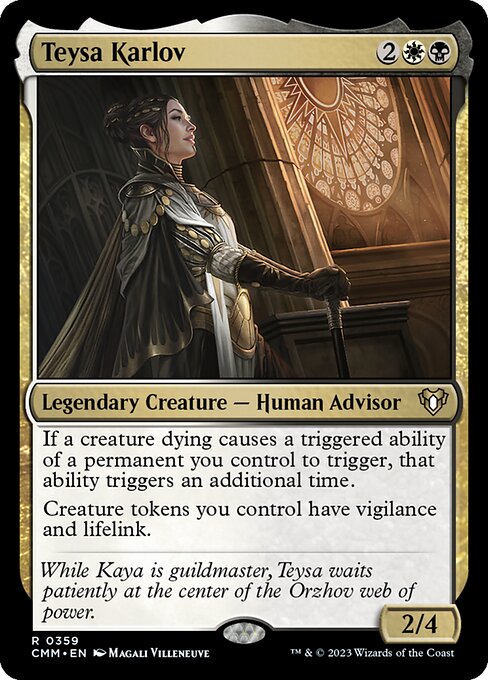
Speaking of representation of disabilities and cards in dialogue with each other, Teysa Karlov is a well-known legend who has been depicted in markedly different ways over a relatively short period.
While her various printings also tell the story of Wizards moving away from the infamous cleavage window, I’m more interested in Teysa’s cane.
Although Teysa has always used a cane in the broader canon, her cane doesn’t appear in-frame until her second illustration, Teysa, Envoy of Ghosts. There, it serves as a subtle but key aspect of the card’s mood and tone, as Karla Ortiz depicts Teysa as simultaneously relaxed and predatory.
On her final legendary card to date, the simply named Teysa Karlov, we behold Teysa fully realized as the power behind the Orzhov, stately robes draped and flowing. Simultaneously, her cane takes on even greater prominence and significance, both graphically (it’s more prominently lit and positioned than on her Envoy card) and literally (she is actively using it). Taken together, Teysa’s illustration is a subtle, beautiful declaration that disabled people are powerful, too.
While Magic art includes a few dozen depictions of people using canes, walking sticks, or staffs, it’s also noteworthy that Teysa is among the youngest characters shown using one. (Technically, Teysa is 112, but apparently that’s considered about middle age on Ravnica, or at least for Orzhov nobility. Must be nice.) Given that cane users span the age spectrum in our world as well, Teysa’s depiction is a welcome piece of representation.
6. Join the Dance
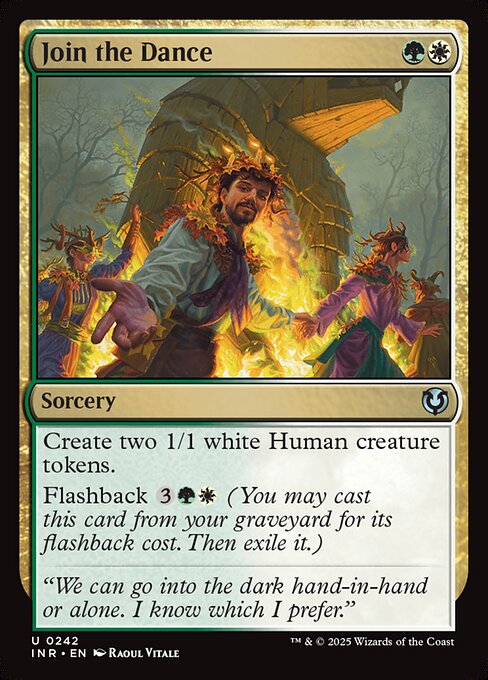
As a game piece, Join the Dance may not seem to merit an inclusion on this list. But this gold uncommon holds a key extra-textual distinction: it was one of the first cards that the official Magic Twitter account published with an alt text image description.
Alt text (short for “alternative text”) is a standard accessibility practice of describing the visual content of images in a textual, non-visual way—thereby making the image accessible to people who are blind, visually impaired, and/or use assistive technology, like screen readers, to browse the internet. Without alt text, a screen reader that encounters a picture can generally only articulate the unhelpful, inaccessible description of “Image.”
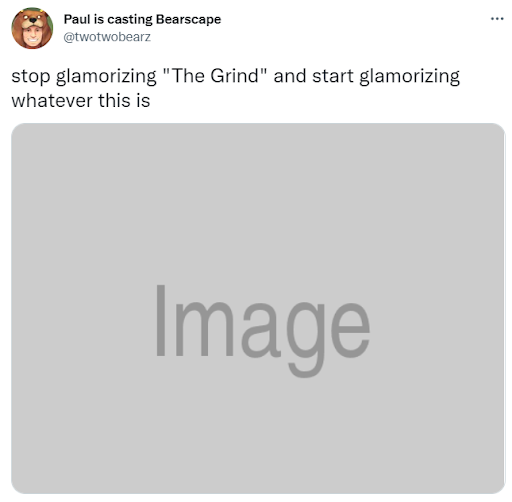
A visual representation of how screen reader users perceive Twitter memes when images don’t have alt text.
Supplying alt text on images is always important, but even more so for preview cards. It takes time for new cards’ rules text to percolate to sites that present information literally, like Gatherer or Scryfall. In the interim, without alt text, people who can’t see the images are shut out of the conversation about new cards.
This problem has persisted for years, and is only growing worse as the frequency of preview seasons accelerates. Although Twitter has supported alt text since 2016, Wizards only started employing it within the past year, and their use of it remains spotty at best. Among the rest of the community, alt text remains uncommon, but the practice has started to pick up stream: Olivia Gobert-Hicks and Incorrect MTG Quotes included it on their recent preview cards; Robert “fireshoes” Taylor adds it to some decklist photos; and Flavor Judge Draws now writes a description for every single one of their delightful visual gags.
Of all the items on this list, this is the one where you—yes, you—have a clear and straightforward ability to make a small but important impact. Almost all of us will never get a chance to concept or illustrate a Magic card, but many of us have a Twitter account, and if you do, I encourage you to practice adding alt text to images you tweet.
While there is still a lot of work to do, I believe the trajectory is positive.
5. Arlinn Kord
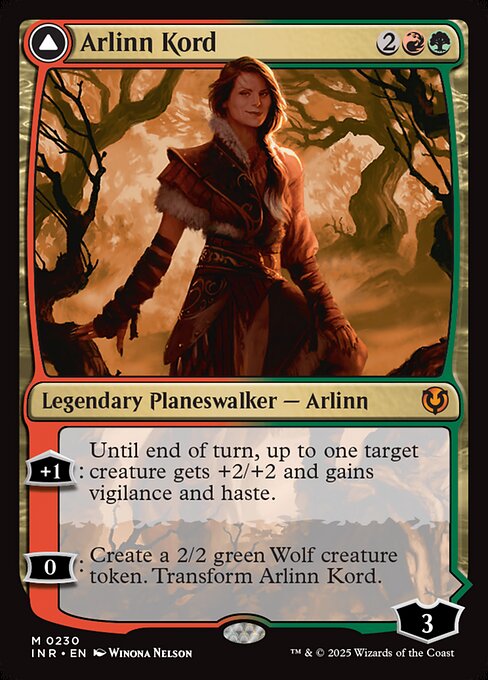
Arlinn Kord bears the scars of a hard-fought life, and she wears them well. Her original art description states she’s approximately 45, and the touches of silver in her hair reflect that. In particular, this concepting puts Arlinn in rare air as a planeswalker who was deliberately introduced on the cusp of middle age. It’s important that Magic’s cast of planeswalkers represent a variety of real-world age ranges, just as the actual player base does.
Arlinn was a central character in the diptych sets of Midnight Hunt and Crimson Vow, emerging injured but ultimately triumphant. In this regard, she casts a stark contrast against Wizards’ recent treatment of several other older heroes, particularly its other older women heroes. Two of the most important recent story beats include the Phyrexians corrupting Tamiyo (one of the few planeswalkers shown to have a thriving family) and killing Jaya (one of the most beloved and iconic older characters)—decisions that feel like a betrayal to many Vorthoses.
In isolation, choosing to kill off a mentor figure is understandable and can certainly make for an interesting and powerful story. But as pieces of an emerging pattern, Tamiyo’s and Jaya’s fates take on a more troubling tone. Meanwhile, Arlinn shows that Wizards can portray older women effectively and thoughtfully.
As the Magic story continues to speed ahead (and as all the planeswalkers may well continue to age with it), hopefully Wizards is listening to concerns of the players who feel neglected, and can swerve to avoid similar missteps in the future.
4. Candlelit Cavalry
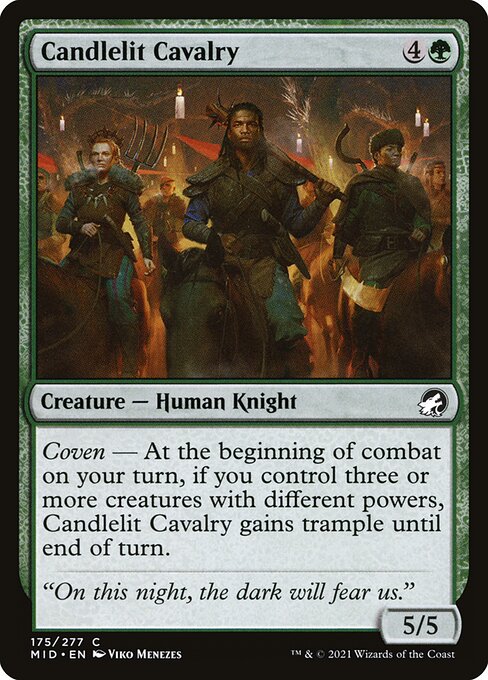
Speaking of Innistrad, this straightforward common from our latest trip to the Multiverse’s scariest plane stands out as an exemplar of Magic’s renewed focus on portraying diverse worlds.
While groundbreaking in many ways, the first Innistrad block featured an extremely homogeneous population, particularly with respect to race and ethnicity: only a couple of cards clearly showed a person of color. Our first return, Shadows Over Innistrad block, reflected a substantially more diverse populace—an upwards trend that continues in Midnight Hunt and Crimson Vow.
Enter Candelit Cavalry. Here, we see the defenders of the Harvesttide Festival arrayed and ready. A Black man sits front and center, accompanied by an older woman. Note, too, the bald person wearing an eyepatch in the background. These seemingly minor details don’t just make Innistrad feel more real and authentic; they also allow more people to see themselves reflected in the Multiverse.
Candlelit Cavalry is a great reminder that the push for representation doesn’t start and stop with high-profile legends and splashy mythic rares. How the everyday citizens of a world are portrayed is also critically important.
3. Kynaios and Tiro of Meletis
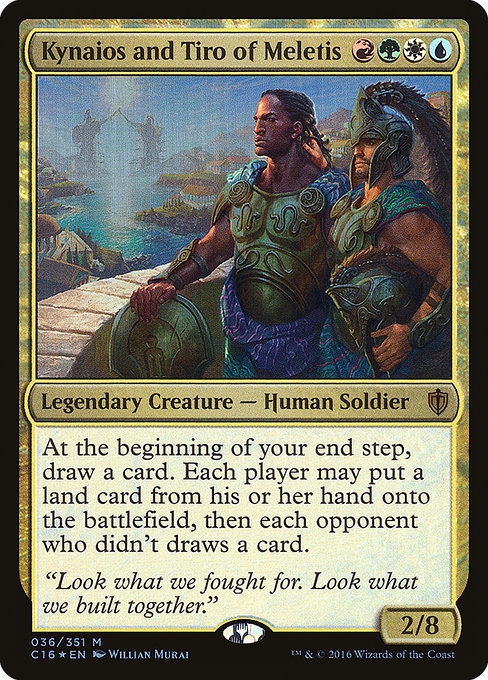
Before we saw Kynaios and Tiro on a card, we saw their likenesses as the Guardians of Meletis. While many keen-eyed Vorthoses noticed that both statues seemed to be male figures—the first depiction of a same-gender couple in Magic card art—this plausibly-deniable representation was indirect enough that many, including myself, found it pretty unsatisfying (even if the flavor was also sadly accurate in depicting a queer couple’s legacy being erased from the annals of history).
2016 changed that.
Thanks to Commander sets being able to revisit the past without having to justify it narratively, we actually got to witness Kynaios and Tiro in their own era. Much like Anax and Cymede, these two lovers and rulers are sharing an intimate moment (fellas, is it gay to stroke another man’s hair while holding his helmet?) with their trademark statue standing proudly behind them.
As Yahenni would say, “The time for subtlety is over, darling.” And how lucky we are.
2. Irencrag Pyromancer
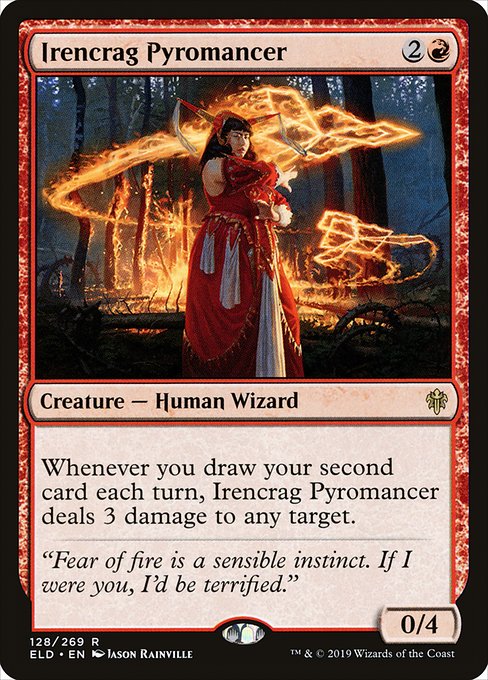
Like much of our society, Magic art is heavily skewed towards depicting thin people. Positive portrayals of larger individuals are few and far between.
Irencrag Pyromancer, then, is a rare but welcome example of an empowered fat person in Magic.
The artist of this phenomenal piece, Jason Rainville, revealed that this representation was no accident: Art director Cynthia Sheppard specifically requested an illustration of a “heavyset badass of Asian ethnicity.”
The community’s overwhelmingly positive reaction to this Embereth mage clearly shows that Wizards was on the right track when they commissioned Irencrag Pyromancer. In spite of that, further representation of fat people on Magic cards remains scarce. I hope that Wizards reconsiders this lack in the future and starts making a stronger push for illustrations of people with a variety of shapes and body sizes.
1. Spike, Tournament Grinder
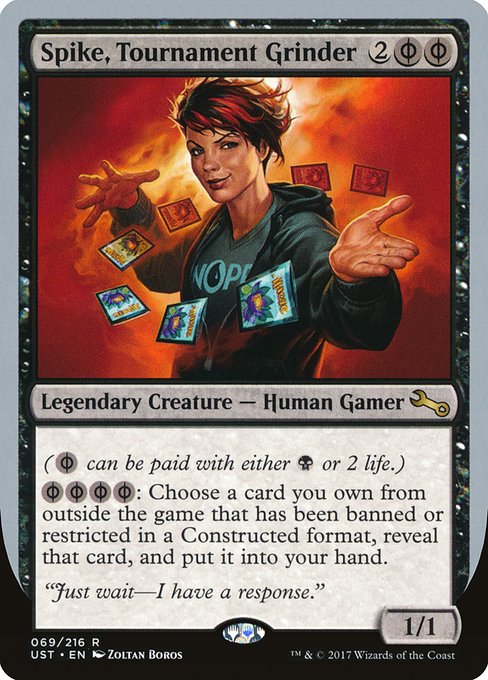
If Serra Angel reminds us that women have always been welcome in Magic, Spike affirms that women will always be part of the game’s future, too.
Women and other people of marginalized genders have long faced structural barriers that hinder or block them from fully participating in the Magic community in the ways that cis men do, especially with regards to Organized Play.
Wizards choosing to depict a woman as Spike—the psychographic of competitive Magic and playing to win—is a clear statement that women belong in tournaments. Just like many of the real-life players who strongly resonate with the card, Spike pushes against the stereotype that all the top players are cis men. She proudly declares that players of all genders deserve to enjoy the thrill of casting busted cards, finding lethal, and making that perfect “in response…” play.
Because the Multiverse is for everyone.
Paul “Bearz” Baranay has judged Pro Tours on three continents and enjoys matching wits with his friends through drafting various bespoke cubes.

